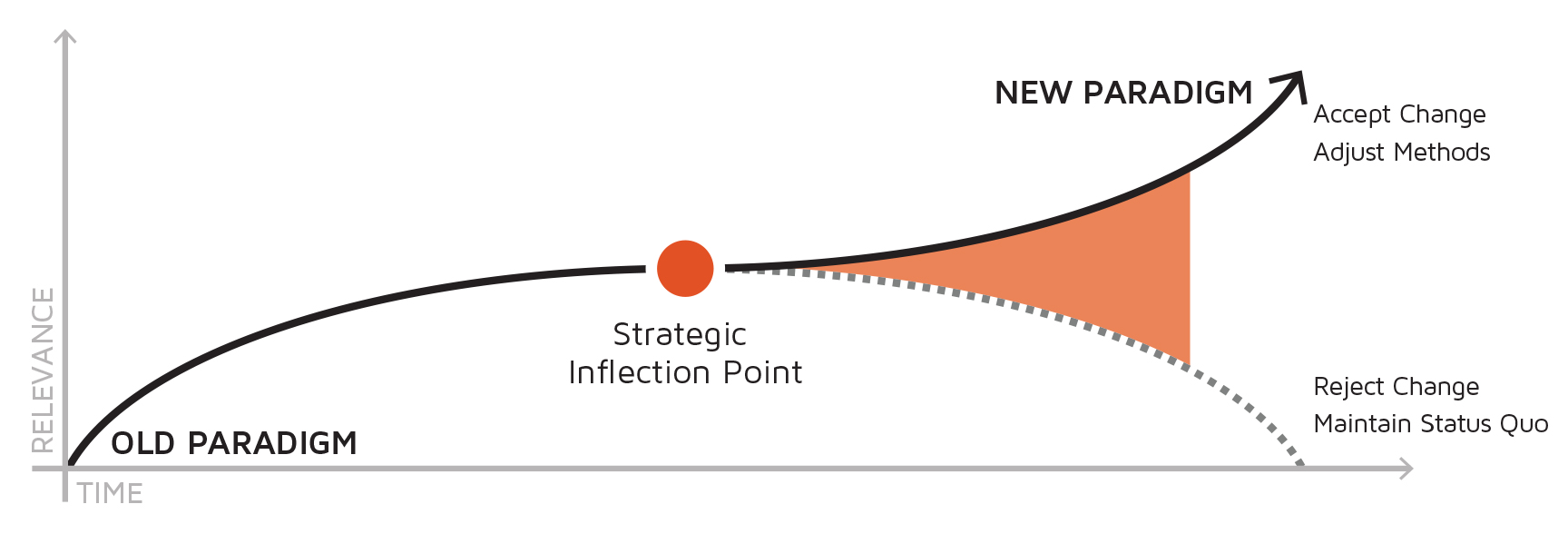Andy Grove and the Response to Disruption
It’s an irony of fate that Andy Grove died last Monday just as Adobe’s Digital Marketing Summit was kicking off in Las Vegas. Adobe is (or likes to think of itself as) the poster child for our thoroughly digitized economy and culture, all of which would be unthinkable without Grove — that is, without Intel, the company Grove built, formed in his own image, and rescued from the brink of extinction more than once.*
Andy Grove was a talented engineer, a fierce debater, and a brilliant manager and motivator. But above all, he was one of the first business leaders to recognize that for the business enterprise, life and vitality depends on incessant rebirth and reinvention. Stasis — even and especially if it takes the form of a vibrant, productive, “well-oiled machine” for creating business value — will lead to ossification and decline if it prevents the company and its culture from recognizing — and boldly responding to — the constantly changing business environment. Grove wrote:
If you’re wrong, you will die. But most companies don’t die because they are wrong; most die because they don’t commit themselves. They fritter away their valuable resources while attempting to make a decision. The greatest danger is in standing still.
In his 1996 book Only the Paranoid Survive (from which this passage is taken), Grove explained his notion of the “strategic inflection point,” which is a “monumental, catastrophic change” in the operating environment of a company.**
(Grove was an early fan of Clayton Christensen’s work and later adopted disruption as a synonym for strategic inflection. Still, Grove — like DCG — tends to use disruption in the normal sense, i.e., “to cause something to be unable to continue in the normal way.” See Christensen’s recent attempt to define and delimit the application of the specific theory of disruptive innovation.)
Grove stressed that such disruptive strategic inflections could have many sources: “new technologies, new competition, new regulations, new customer values and habits, etc.” Managers need to be able to distinguish “garden-variety change” – i.e., normal operational challenges – from the critical disruptions that threaten the very survival of the company and force it to navigate what he did not hesitate to call “the valley of death.”
Grove’s simple graphic (our version above) clearly illustrates how a set of business practices, market perspectives, and insights about buyers – the “old paradigm” – succeeds for a time in producing “relevance” – meaning whatever has been deemed as a positive outcome, such as revenue growth, market penetration, or customer acquisition.
When the strategic inflection occurs (which, as Grove later admitted, is usually the manifestation of an ongoing process rather than a point in time), the established practices no longer deliver the desired results. In fact, adhering to the status quo leads to decline and irrelevance. Instead, continuing success depends on identifying, understanding, and adopting a “new paradigm” that reflects and takes advantage of the post-disruption environment.
The most important part of Grove’s visualization of the strategic inflection is the delta that opens between the declining old paradigm and the new paradigm that can deliver continued business relevance. This so-called dissonance gap marks the divergence between “business as usual” and what you should be doing to accommodate and leverage the disruption. The business challenge is to correct course before the gap becomes too large to cross – or to risk the fate of Kodak, Blockbuster, and Borders. (And RIMM, and Nokia, and Radio Shack, and Sears, and etc. There are many forms of corporate death; lingering on as a shriveled version of the past glory is perhaps the most cruel.)
Grove acknowledged that a disruptive strategic inflection could impact an individual business or an entire industry. Today, digital disruption has resulted in the empowerment of consumers and created the need for companies to create and manage positive and differentiated customer experiences. In this sense, it represents the most fundamental disruption, since this consumer demand affects virtually every business in every industry, worldwide.
It is a measure of Andy Grove’s vision and acuity that he not only lead the company at the center of the digital revolution but also foresaw and prescribed the response to the disruptions it would cause.
—————————–
* In naming Grove Man of the Year in 1997, Time Magazine called him “the person most responsible for the amazing growth in the power and innovative potential of microchips.”
** This analysis of Grove’s notion of strategic inflection draws from my DCG Insight Paper “Beyond Marketing: Why Digital Disruption Requires a Deeper Transformation”
Other memorial articles about Andy Grove:
The Economist, “The Man Who Put Intel Inside”
Clayton Christensen, “What I’ll Miss About Andy Grove”
Ben Thompson, “Andy Grove and the iPhone SE“









